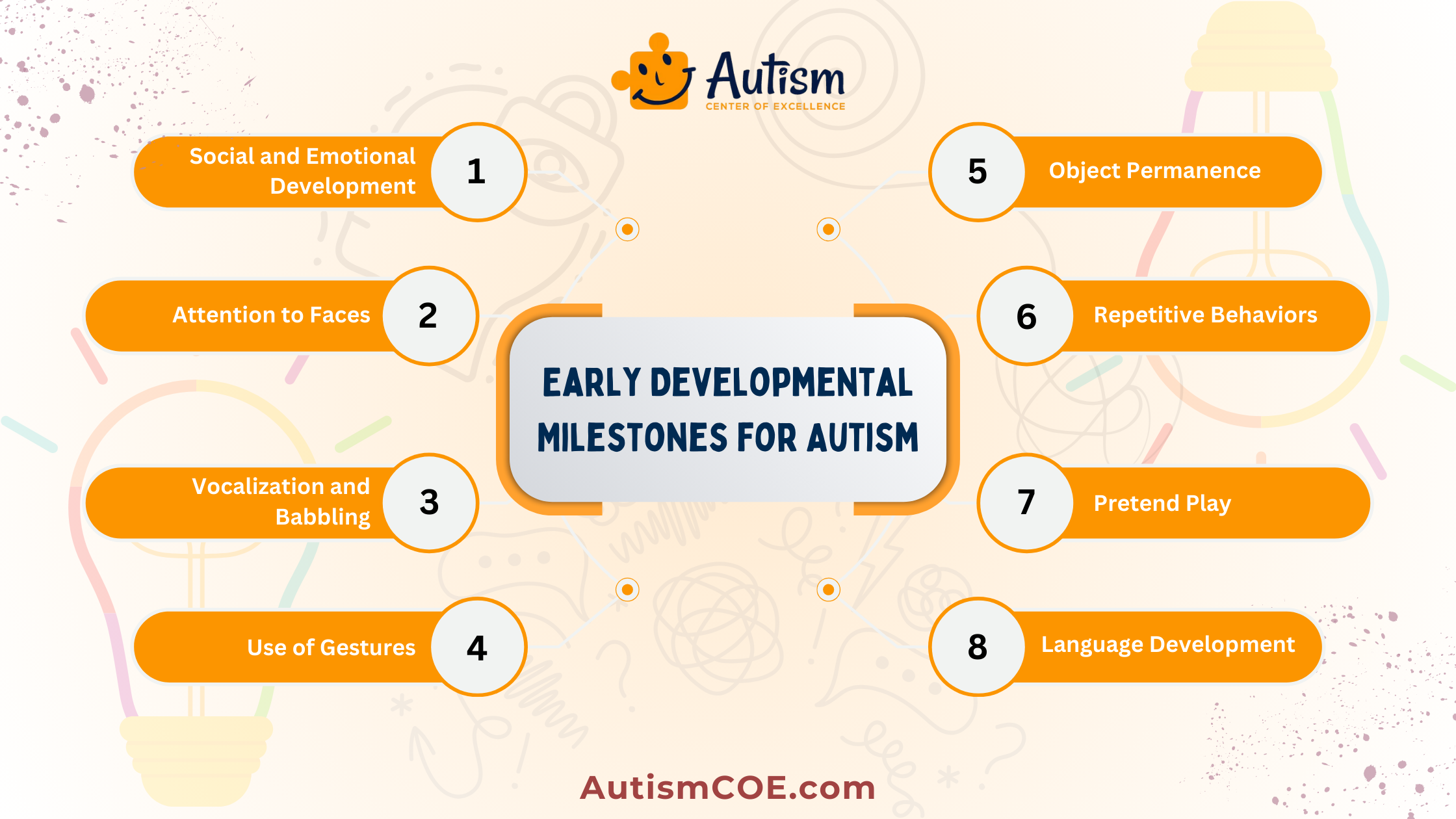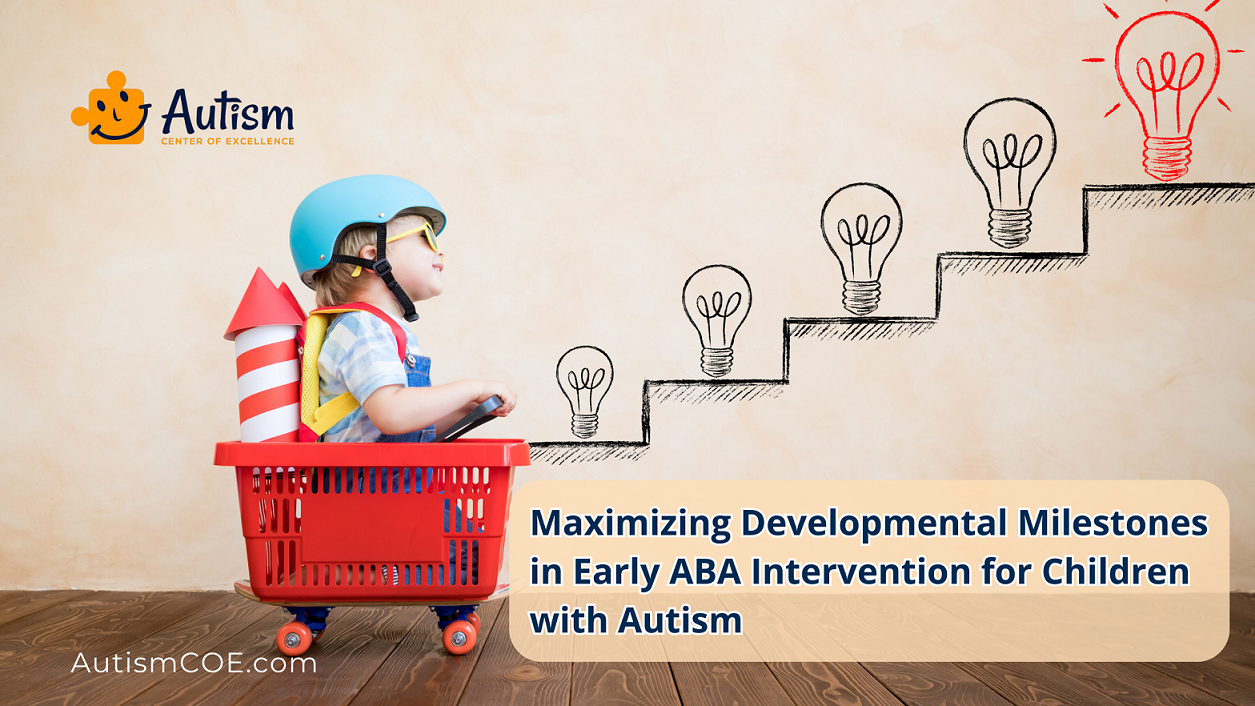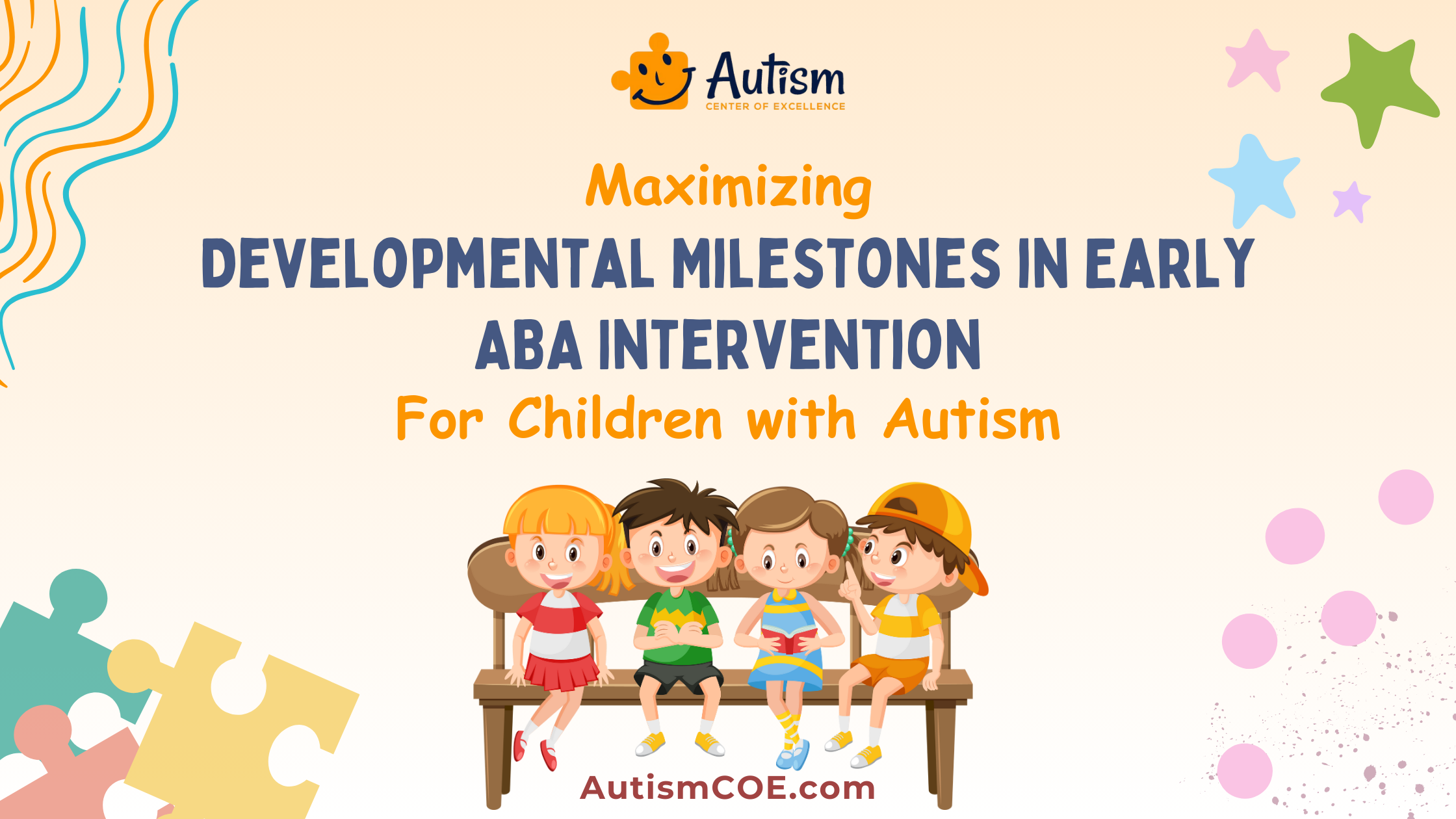ABA-based Early Intervention is a crucial element in equipping children with the necessary skills for development and to draw out their best abilities. ABA has shown a breakthrough approach by tailoring behavioral strategies for every individual and this methodology has transformed the development process. The main focus of the article is on the role of ABA Therapy in children with autism spectrum disorders which is a part of Early Intervention Programs and thus provides the most notable influence on their developmental process.
Autism Developmental Milestones
The Developmental milestone is an important phase for a kid that includes improvements in either physical, emotional, or Intellectual Growth. For children with autism, these milestones could be seen as different and the time that it takes may be longer than it is for those kids who are not in this category. The milestones could encompass skills like rolling over for the first time, smiling for the first time, or running around while saying bye-bye. In children with autism, these abilities may be delayed or expressed differently because of the way their brains process information differently.
The autism developmental milestones are vital guides that are essential to clinicians, educators, and parents in tracking a child’s progress for his/her growth and development. The phases allow adults to get a general idea of what skills the child with autism will develop next and make predictions concerning them. Those milestones are highly significant too when it comes to providing each child with a personalized treatment, including Applied Behavior Analysis (ABA) intervention. Recognizing these milestones, one can get a chance to use Early Intervention Strategies beneficially, leading to an improvement in the situation of children with autism in the long run.

Difference Between Autism and Normal Development Delay
Autism and regular development have unique developmental pathways, and distinguishing these differences was initially the essential step toward early diagnosis and intervention.
A lot of children with the Autism Spectrum Disorder (ASD) have developmental delays, which are delays to some of their abilities for example cognitive, emotional, and social development compared to other children meaning they attain such milestones slowly.
It does not mean that the growth of these children stops, but transitionally the order of growth may be different for them. Some children with ADS may experience delays or steps backward in their development.
On the contrary, a typical toddler shows the symptoms of speech delays, sensory difficulties, and issues of manipulation. While these activities do not prove that autism exists, they also do not disprove it. The main difference is the degree and pattern of these behaviors.
For example, even though meltdowns might be common for toddlers, kids with ASD will likely have more frequent, more intense, or lasting meltdowns. These delays are usually found in one or more developmental areas amongst children diagnosed with autism, but delays in the development of other children do not necessarily make them autistic.
It’s worthwhile to keep in mind that each kid is special and moves forward in their own way, whether they have autism spectrum or any other disability.
How Does Autism Affect Developmental Milestones?
ASD may impact the way a child progresses via developmental milestones; thereby, causing both the delay and the deviation from what is considered a normal development. This delay involves poorer overall functioning compared to peers who are not affected by ASD in the areas of social, emotional, and cognitive development. As an example, most children make a sound for their names by the age of nine months, make eye contact, and smile for social occasions, but children with ASD might not respond, hold eye contact, or show a smile in those situations. These children often show uncommon patterns of behavior, such as playing with objects while avoiding eye contact or not looking for things that fall.
Variations in Developmental Patterns in Children with Autism
Conversely, the first brain architecture abnormalities of ASD appear typically at 7 months, which is, however, as late as behavioral symptoms. Such difficulties may occur in areas like language, social activity, and habitual behaviors. Yet the accurate interpretation of a behavior is not something that is simple and an exact indication for autism is not present. Every child with autism is special in its own way, and the symptoms may show up at a different time or be more or less severe. Accompanying with ongoing monitoring of your child’s development as well as taking advice from a professional when you have any concerns becomes important as early detection and intervention can be made.

What are the Early Developmental Milestones for Autism?
Knowing the early stage of autism development milestones for autism can be an important step in getting the right diagnosis and treatment of the disease at its initial stage. Below are these telling key milestones which will be a crucial guide for the parents and caregivers in identifying the possible signs of autism.
1. Social and Emotional Development:
One of the First Symptoms of Autism is a Slowdown in the Social and Emotional Development. For example, babies aged 9 months usually calm down within a few minutes after a caregiver leaves. Though this is not the case for all children with autism, the severity of the discomfort may be seen to be much higher.
2. Attention to Faces:
By six months babies usually begin to notice the human faces around them more than before. By contrast, children, who were diagnosed with autism, can get perplexed or show little interest in the unknown face to others.
3. Vocalization and Babbling:
Babies are now able to utter first sounds and babble actively by the 9th month. Children diagnosed with autism may exhibit speech patterns that are late or different.
4. Use of Gestures:
It takes just about their first year for most children to respond to simple gestures like waving, pointing at objects, and clapping hands. These kids are usually less expressive via these gestures or show less interest in other children.
5. Object Permanence:
By the end of the nine months, babies actually start for objects when they’re put aside. There may be a delay or an absence of these in children with autism.
6. Repetitive Behaviors:
Children with autism are likely to present abnormalities in restrictive, repetitive, and obsessive behaviors at an early age. Such behavior may include hand flapping, spinning, or extremely keen interest in some particular topics or objects.
7. Pretend Play:
Pretend play is an extremely dramatic moment in the developmental ladder, which usually appears in 2-year-old babies. This might be due to limited interest in pretend play from children with autism or to a limited range of repertoire of pretend play activities among them.
8. Language Development:
Related to language acquisition, we can see a broad range of development in children with autism. Some of the infants can have a problem with Speech Delay, some others may be not able to speak at all. Children can progress in their language development and then start regressing.
Recognize that each child is different and these milestones are only guidelines. However if you even suspect that your child is not developing normally, you always have an option to speak with an expert.
Join Our Weekly Newsletters!
Subscribe now to stay updated with our latest email updates.

How Early ABA Intervention Can Help Maximize Developmental Milestones in Children with ASD?
A lot of the studies have observed how early interventions benefit those affected in a positive way when it comes to the children with ASD. Detecting and dealing with the issues early can help the child to overcome omultiple skill areas, health issues, safety concerns and many others, enhancing the quality of life.
Maximizing Child Development with EIBI/ABA
Research suggests that pairing Early Intensive Behavioral Intervention (EIBI)/ABA with developmental/Naturalistic Developmental Behavioral Interventions (NDBI) approaches could maximize development in children with ASD.
Improving Cognitive and Language Function
Over many years of study, the effectiveness of ABA in reducing ASD symptoms and increasing Language and thinking abilities has completely been proven.
Enhancing Physical Skills
Physical therapies are frequently a part of the early intervention plan as children with autism can have issues with their walking and other motor skills.
Identifying Red Flags
The first step towards early intervention is to note down the falling down development milestones and potential signals in a child. Through early detection, signs of autism can be spotted in the initial stage. This is the right period for the parents and other experts to form a plan of action.
The Effectiveness of ABA Therapy
Furthermore, as additional evidence comes up, ABA therapy is one of the significant aspects of the strategy that are helpful in children with autism in fulfilling their respective potentials.
Better Outcomes with Early Intervention
The therapeutic process for children during the early years in school can clearly help in the area of overall child development. Kids whose autism care is initiated at the early development stage and then in each stage of their development are likely to have better outcomes as compared to those who receive it late.
Benefits and Long-Term Impact
ABA therapy has been proven to be one of the highly efficient methods for managing symptoms in children with autism. Utilizing this technique, desirable actions are highly priored and undesired emotions and behaviors are minimized that ultimately resulting in the improvement in the level of socialization, communication and expression of language.
✅ Reduction in Autistic Symptoms:
Research indicates that symptoms of autism are diminishing more in the case of younger kids compared to older ones thus highlighting the importance of early intervention. Also, adults may have variations in terms of acquired skills that could be different than what an ABA would offer, for instance, communication skills to effectively express their thoughts and feelings could greatly affect their lives.
✅ Developmental Milestone Achievements:
The ABA therapy methods during the early years are the best recipe that can significantly influence developmental stages. Such programs may prepare children with an autism spectrum disorder to master these standards at a speed comparable to that of their age-mates.
✅ Prevention of Long-Term Issues:
Initially engaging a child with ABA therapy as long as this autistic disorder is diagnosed and treated early, can prevent later occurring problems in their development and help the child take the best developmental path. It assists in laying a strong foundation for future learning and skill acquisition.
✅ Sustained Improvements:
Research about ABA interventions confirms that the gains children make in their early years are maintained with time. This positive result lasts till the end of the intervention and the children keep the gains in overall intelligence and language scores thus proving the sustainability of early learning.
Frequently Asked Questions & Answer
How Does Parental Involvement Affect the Success of ABA Therapy in Early Intervention?
Studies revealed that parents who eagerly engage their child in ABA therapy often positively contribute to the child’s development as well. This is simply because the parents are responsible for imparting the required guidance to facilitate thetaking up and retention of the new knowledge. In addition, parental commitment results in the success of the treatment plans and outcomes.
What is the Most Commonly Used Intervention for Autism?
ABA theraphy has definitely gained popularity among practitioners as it is the most progressive and effective treatment for autism. The idea behing the therapy ABA is that the behaviors are learnt and that’s why they can be precisely controlled and shaped through modification and training with time. This is another therapeutic approach that enhances the specific behaviours: social skills, communication talents, and academic skills; and also fosters the development of adaptive learning skills such as fine motor dexterity, prepping, grooming, home management, punctuality, and job competencies.
What is the Best Age for Early Intervention?
The ideal age for early intervention depends on the specific children and their needs. Although there are different researchers making different conclusions, it seems that the effect of interventions is better when implemented as early as possible. Early intervention programs are possible from the moment a child is diagnosed which is usually when he or she is around 2 to 3 years of age.
What are the Three Main Goals of Early Intervention?
The purpose of early intervention is the following three strands:
- Enhance the child’s development
- Ensure the family gets the required care.
- Give the kid and the family an opportunity to contribute to society’s development.
Conclusion
Early detection and treatment of Applied Behavior Analysis (ABA) is key to most of the children who are diagnosed with Autism Spectrum Disorder (ASD). This is the way the treatment develops behaviors used in socialization, communication, and expressive language, which are extremely important in the early stages. It helps in developing behavior and constantly brings attention to the growth aspect of the child.
Further, the implementation of ABA therapy for Autism during early childhood leads to a profound change in the process of Developmental Milestones. Students with Autism Spectrum Disorder (ASD) would achieve those skills at a pace roughly comparable to that of their typically developing peers and hence eliminate long-term developmental challenges for them. Research shows that once ABA treatment is over, children continue to exhibit improvements consistent with the initial impact of ABA early intervention.
Please Note: The content of this blog is for informational purposes only and should not be considered a substitute for professional medical advice, diagnosis, or treatment. Consult a qualified healthcare professional for personalized guidance tailored to your specific situation.

Bhavika Bhasin (Author)
Bhavika Bhasin is the Research and Marketing officer at AutismCOE. She works with children and adults with ASD. Her clinical research includes evaluating various available autism screening and diagnosis methods and their efficacy. She is currently developing a novel screening exam that is indicated to be more accurate than the existing available exams. She is also writes articles papers for various publications.


